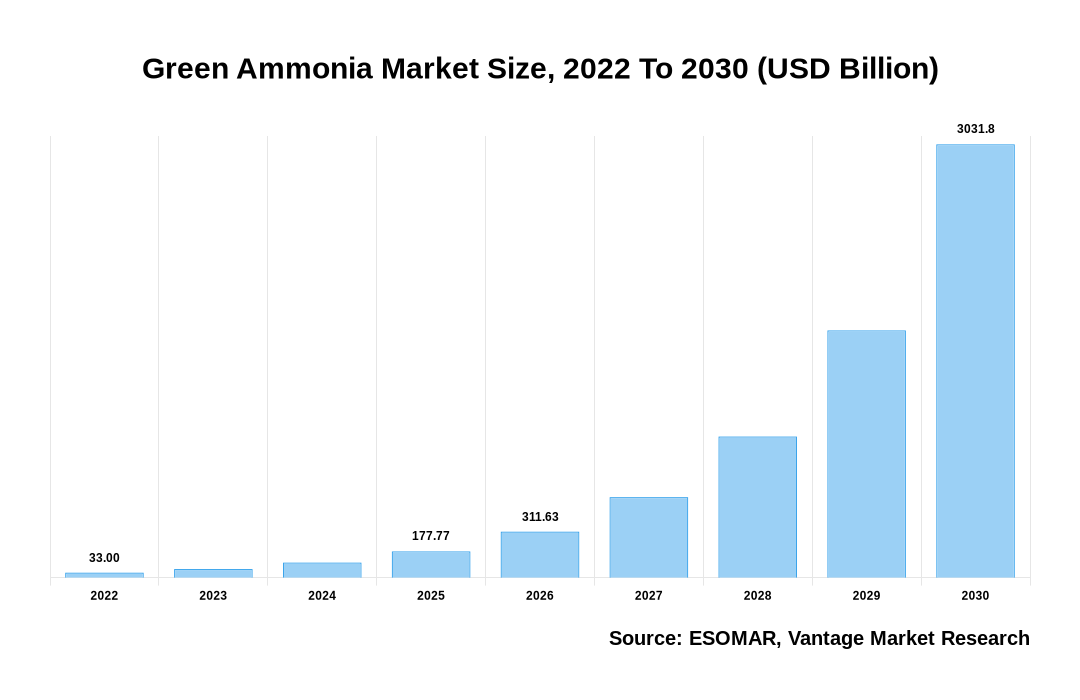Global Green Ammonia Market
As stated in our extensive report; the Global Green Ammonia Market accounted for 0.28 Billion in the year 2022 and is forecast to reach USD 14.5 Billion by 2030 at a CAGR of 75.3%.
A hundred years ago ammonia saved the world through the mass-scale production of nitrogen fertilizers which prevented famine and it is doing it again but in the ongoing period it will be Green Ammonia. Increasing investment in industries such as feedstock products, agriculture, fertilizer, transportation, power generation, implementation of stringent environmental regulations, and green fertilizers is going to propel the Green Ammonia Market. Also, the rising demand for the products such as marine fuel and shipping in the transportation industry as they emit zero carbon and leave no sulfur traces, which leads to better air quality is expected to drive the market growth.
Click To Get a Free Sample On the Research Study

In Sea transportation, as it requires a good source of heat and electricity green Ammonia accounts as efficient it also has applications in gas turbines, internal combustion engines, industrial furnaces, and fuel cells. Green Ammonia is the best alternative for the shipping sector as it reduces carbon emissions and also has less volumetric energy density which makes storage feasible in comparison with other fuels.
Furthermore, decarbonization of maritime industry along with demand for clean fertilizer production is further anticipated to accelerate the Green Ammonia market growth. However, Green Ammonia is highly cost intensive, which has prevented the green ammonia expansion in recent years.
Factors Influencing Global Green Ammonia Market Growth
The growth of the global Green Ammonia market can be attributable to the following:
- The rising carbon emissions which increase greenhouse gas emissions (GHG) are due to the manufacturing of one ton of ammonia which releases an average of 2,767 tons of CO2, the government wants to cut carbon emissions by 60% and hence government measures towards cleaner environment will fuel the market growth.
- The market is driven by the rapid growth of industries such as transportation, fertilizers, power generation, agriculture, and others.
- The increasing scope of green ammonia in various industrial applications will propel sales of it in the coming years.
- During the forecast period, numerous new international players are expected to enter the market, which is anticipated to accelerate the development of the Green Ammonia market worldwide.
Europe region Dominates the Global Market
In 2021, Europe had the biggest revenue share (20.25%), dominating the Green Ammonia market. The adoption of electric vehicles in the area and increased R&D for hydrogen production are credited with this surge. In addition, the market expansion is being fueled by government assistance, increasing investor involvement, and the viability of the technology in the area.
By 2030, the Asia Pacific market is anticipated to grow at a CAGR of 140.6%. This is a result of government policies and programs that aim to cut carbon emissions and promote renewable energy. For instance, the Indian government has offered subsidies to encourage the usage of electric cars there. Due to the growing adoption of technological improvements, Spain and Germany are two countries in the European region where the product is in great demand. With the industry becoming more concentrated, Europe is home to numerous ammonia production facilities and offers booming potential for manufacturers.
Conclusion
The overall Green Ammonia market growth has been favorably impacted by Increasing investment in industries such as feedstock products, agriculture, fertilizer, transportation, power generation, implementation of stringent environmental regulations, and green fertilizers.
The well-known players of the Global Green Ammonia Market include ACME Group (India), Air Products Inc. (U.S.), Aker Clean Hydrogen (Norway), AquaHydrex (U.S.), Ballance Agri-Nutrients (New Zealand), BASF SE (Germany), CF Industries Holdings Inc. (U.S.), Dyno Nobel (U.S.), Electrochaea (Germany), Enaex Energy (Chile), Enapter (Italy), Eneus Energy Limited (U.S.) and others.
![[Market Research Reports] – Research Google News Blog | VMR.Biz](https://www.vmr.biz/wp-content/uploads/2022/12/logo-removebg-preview.png)











